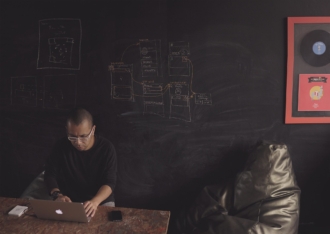“Things which matter most must never be at the mercy of things which matter least.”
– Goethe
In his 2013 book, The ONE Thing: The Surprisingly Simple Truth Behind Extraordinary Results, author Gary Keller reminds us that everyone has 24 hours in a day.
So, why do some people earn more, achieve more, and get more done? They “go small,” he says:
“When you want the absolute best chance to succeed at anything you want, your approach should always be the same. Go small.
‘Going small’ is ignoring all the things you could do and doing what you should do. It’s recognizing that not all things matter equally and finding the things that matter most.
It’s a tighter way to connect what you do with what you want. It’s realizing that extraordinary results are directly determined by how narrow you can make your focus.”
This is such great advice — and it reminds me of the expression “you can do anything, but you can’t do everything.”
I do know that focusing on one thing at a time is the foundation of our company. I started Jotform in 2006, and we’ve spent 12 years growing a single idea into a product that serves nearly 4 million people.
I know we could chase side projects, but I think success comes from going deep, not broad. Our 110 employees are all dedicated to one product. We’ve never branched off.
Going small to follow one path sounds easy, but there are fresh opportunities and shiny objects around every corner. Distraction is everywhere.
There are times when you want to test the waters, and creativity often requires sampling.
But again, if you truly want to move the needle, it demands a narrow field of vision.
For example, our company always chooses an annual focus area. This year is about data.
Across all our teams and functions, everyone is working to boost user productivity by leveraging data. That task looks different for each employee, but we’re aligned with a single, shared goal.
When you focus on what’s important, the results can be incredible. This focused approach brought us 1 million new signups last year alone.
Lay out all the options and pick what really, truly matters. Set your focus area and stick to it.
Start as small as possible
The advice to “go small” works on multiple levels. Choosing your goal or main project is the first step. Then, once you know what you’re trying to achieve, zoom in closer.
When we’re working on a major project, I always try to step back and ask:
“What’s the smallest version we could create that would still produce results?”
It’s the same idea as building a Minimum Viable Product.
Once you have that mini version, gather feedback. Refine and work your way up to a bigger, better model. Keep going and you’ll achieve more than you thought was possible.
Create automated systems

Technology is far from foolproof, and until recently, our admins were constantly tackling server issues at 3 a.m.
Every time it happened, I reiterated the need to find a real solution; one that didn’t require midnight wake-ups.
But, our team was used to working on-call. It had almost become a badge of honor for them. And while I appreciated their dedication, there had to be a better way.
Eventually, we installed automated tools that tell us, for example, when our servers are 80% full. They notify us again when the servers reach 85% capacity.
Now, we never hit that 95% panic zone. We’ve automated an issue that drained our focus.
Systems aren’t exciting, but they are essential. Create efficient processes and automate as many steps as possible.
You’ll free up valuable time and energy to stay focused on your “one thing.”
But how do you apply the “go small” approach to teamwork?
Collaboration and teamwork
“So often people are working hard at the wrong thing. Working on the right thing is probably more important that working hard.”
– Caterina Fake, co-founder of Flickr and Hunch
Designate a leader
Sports teams need coaches and captains. Orchestras need conductors.
Group activities almost always function better when someone’s leading the way, even if the work is highly collaborative.
At Jotform, all of our cross-functional product teams have leaders — and good ones dramatically increase both focus and productivity.
So, what makes a strong leader?
In my experience, it’s someone who can make quick, smart decisions. They listen closely, gather information, and make choices that move the group closer to its goals.
If you’re working solo, it’s equally important to step back from your daily tasks and measure what matters. Be your own leader.
You can always reach out for help, too.
Whether it’s a friend, colleague, mentor or advisor, a different perspective is often highly valuable — but remember that the final decisions are always yours.
Explore — within your boundaries
All this talk of single-minded focus can sound really dull — especially if you’re a creative person. I get it.

But doing one thing at a time isn’t about boring yourself into efficiency. There can still be room for exploration if you create clear boundaries.
Build your sandbox, and then you can play in it.
Because we spend a full year chasing one big goal, our teams are welcome to follow some tangents along the way. There’s no rush to the finish line.
I also realize that off-the-wall ideas can spark innovation, so we encourage experimentation.
If your team is eager to explore, set some markers so you don’t get lost.
For example, our Friday “demo days” are the time when everyone checks in and shows what they’ve done.
If a team has gone off the rails, we can gently bring them back on track. Usually, though, we’re excited about what they’ve accomplished.
You can set up markers as a solopreneur as well. Think of your project as a large circle that contains lots of smaller circles, or checkpoints.
Once you have those boundaries in place, you’re free to wander.
Productivity and technology
In a 2010 study published in the journal Science, Harvard University psychologists Matthew A. Killingsworth and Daniel T. Gilbert discovered that people spend almost 47% of their waking hours thinking about something other than what they’re currently doing.
Even more striking? Distractions make us unhappy.
As Killingworth explains,
“Mind-wandering is an excellent predictor of people’s happiness. In fact, how often our minds leave the present and where they tend to go is a better predictor of our happiness than the activities in which we are engaged.”
That’s a stunning thought: being focused can actually make you feel better, regardless of what you’re doing.
From starting a business to finishing a spreadsheet (without checking Instagram), single-tasking will not only help you achieve great results, but you’ll enjoy the process a lot more.
Startup gurus and productivity experts have endless suggestions to help you stay focused, but here’s what consistently works for me:
Box your time
Creating time limits is oddly motivating (and effective).
Whatever you want to do, try “boxing” it into a set time period and ignore distractions, including email, calls, texts, making coffee, alphabetizing your bookshelf, or grooming the cat.
Get laser focused for that set period of time and then take a break. Repeat as needed.
The Pomodoro Technique is one example of this strategy, which breaks each work sprint into 25-minute intervals.
Timeboxing can also apply to large endeavors. That’s why we set year-long goals. We draw a 365-day boundary around our pursuit and stay the course.
You can apply this same principle to projects, teams, products, or just about anything else that requires true focus.
Box your energy
We all have energy limits. Even the “sleepless elite” (high-performers like Pepsi CEO Indra Nooyi and fashion designer Tom Ford) will eventually run out of fuel.

Doing one thing at a time will preserve your precious energy. And just like timeboxing, you can get even more intentional about shifting your energy toward what matters.
For example, if I have a big interview or presentation on my calendar, I’m careful about what I schedule around it.
I try to avoid meetings. I get more sleep. I eat more leafy greens and I do what I can to stay relaxed. I’m “boxing” my energy toward an important goal.
Home and personal life
“Focusing on one thing and doing it really, really, well can get you very far.”
– Kevin Systrom, co-founder of Instagram
In June 2018, the makers of a message board app surveyed over 11,000 employees at 30 of the biggest technology companies.
They asked, “are you currently suffering from job burnout?” and participants could only answer “yes” or “no.”
More than 57% said “yes.”
The survey covered just 30 tech firms and the results are self-reported (meaning the participants weren’t examined by doctors, psychologists or other experts), but I don’t think their burnout rates are shocking.
Many people are struggling to stay on what can feel like a treadmill without a “stop” button.

The tech-fueled blur between work and personal time can be difficult — and confusing.
Where are the boundaries? Do you need to check your email on weekends? Most people don’t know.
For example, a study in 2015 showed that while 97% of full-time workers had some flexibility to work when and where they wanted, only 40% received any guidance from their employers on what that flexibility should look like.
And if you’re an entrepreneur or business owner, it’s all in your hands.
The solution? Create as many boundaries as you can, within your sphere of influence.
Make a clean break
As much as possible, separate work from your personal life.
I know this might sound overly simple, but even if you work from home, it’s up to you to create real limits.
Set office hours, for example, and don’t clock in outside those periods.
When I leave the office, I do everything I can to leave work there, too. I want to be present for my family. I want to enjoy my time with them — and I need to rest and recover. I don’t work on the weekends, either.
If I do have a new idea on Sunday afternoon, for example, I’ll send a quick note to myself (but I won’t dig into it).
If I want to share something with a team member, I will send them an email, but I’ll write “FOR MONDAY” in the subject line.
The same rules apply to staff. I’ve asked our teams to remove Slack from their phones. We encourage them not to work after they leave the office.
And we really do try to walk this talk.
If I see emails at night, I remind people that they should wait until the next morning (and then I try to take my own advice).
Take real time off
I can’t say it enough. Even if you’re working hard to build a business or accomplish great things, downtime is not optional. You need to rest.
Every year, I take at least a full week off from my company and head back to my hometown to help with the olive harvest.
Your body needs to recover, your brain needs to consolidate all those inputs, and you’ll be infinitely happier and more productive if you give yourself a break.
The data confirms it:
- After a vacation, 64% of people say they’re “refreshed and excited to get back to my job.”
- Hiking in nature and staying disconnected from all devices for four days can lead to a 50% spike in creativity.
- If employees took just one extra day of paid leave each year, the result would add $73 billion in output to the U.S. economy.
I could go on, but I’ll leave it there.
So, whether you’re crafting a business plan, writing a novel, lifting weights, or perfecting your Bolognese sauce, give it everything you have.
Do that one, most important thing and then move on.
It’s that simple — and that powerful.







































































Send Comment:
2 Comments:
More than a year ago
True that. The essence of Productivity indeed lies in Doing one thing at a time. For too long, i thought myself to be of the likes of Elon musk and others and believed that i Could divide my focus across various tasks and then be a master of them all. However, this wasn't the case.
The trick of Timeboxing could really be a Game changer, if done right.
More than a year ago
Thank you for such a Lovely post. I too believe that the Real Hack or trick to get more done is by Doing less.
Multi tasking and Juggling between several jobs at a Time will eventually end up in not getting anything done.